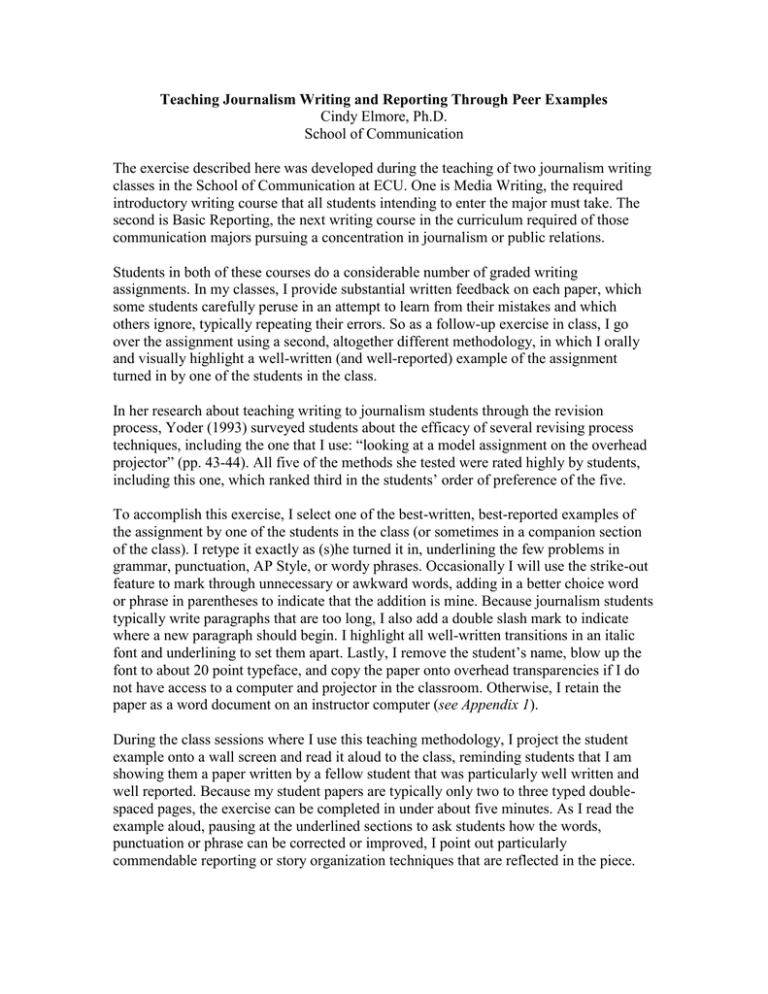Teaching Journalism Writing and Reporting Through Peer Examples Cindy Elmore, Ph.D.
advertisement

Teaching Journalism Writing and Reporting Through Peer Examples Cindy Elmore, Ph.D. School of Communication The exercise described here was developed during the teaching of two journalism writing classes in the School of Communication at ECU. One is Media Writing, the required introductory writing course that all students intending to enter the major must take. The second is Basic Reporting, the next writing course in the curriculum required of those communication majors pursuing a concentration in journalism or public relations. Students in both of these courses do a considerable number of graded writing assignments. In my classes, I provide substantial written feedback on each paper, which some students carefully peruse in an attempt to learn from their mistakes and which others ignore, typically repeating their errors. So as a follow-up exercise in class, I go over the assignment using a second, altogether different methodology, in which I orally and visually highlight a well-written (and well-reported) example of the assignment turned in by one of the students in the class. In her research about teaching writing to journalism students through the revision process, Yoder (1993) surveyed students about the efficacy of several revising process techniques, including the one that I use: “looking at a model assignment on the overhead projector” (pp. 43-44). All five of the methods she tested were rated highly by students, including this one, which ranked third in the students’ order of preference of the five. To accomplish this exercise, I select one of the best-written, best-reported examples of the assignment by one of the students in the class (or sometimes in a companion section of the class). I retype it exactly as (s)he turned it in, underlining the few problems in grammar, punctuation, AP Style, or wordy phrases. Occasionally I will use the strike-out feature to mark through unnecessary or awkward words, adding in a better choice word or phrase in parentheses to indicate that the addition is mine. Because journalism students typically write paragraphs that are too long, I also add a double slash mark to indicate where a new paragraph should begin. I highlight all well-written transitions in an italic font and underlining to set them apart. Lastly, I remove the student’s name, blow up the font to about 20 point typeface, and copy the paper onto overhead transparencies if I do not have access to a computer and projector in the classroom. Otherwise, I retain the paper as a word document on an instructor computer (see Appendix 1). During the class sessions where I use this teaching methodology, I project the student example onto a wall screen and read it aloud to the class, reminding students that I am showing them a paper written by a fellow student that was particularly well written and well reported. Because my student papers are typically only two to three typed doublespaced pages, the exercise can be completed in under about five minutes. As I read the example aloud, pausing at the underlined sections to ask students how the words, punctuation or phrase can be corrected or improved, I point out particularly commendable reporting or story organization techniques that are reflected in the piece. There are times when I have not chosen to show the class a student paper that is too well done, because it gives us little to talk about. And while I leave examples anonymous, I can always tell that many of the students whose work is being featured enjoy the validation of having it shown to the class. As a result, I try to show different students’ work each time I use this method so that, over the course of a semester, five or six or seven students find their work highlighted in this way. I do not show badly written student papers, in an effort not to publicly embarrass someone. However, for some assignments, I will often take 15 or 20 particularly bad sentences from multiple students’ work and make a handout of them (see Appendix 2), asking the class how to correct or improve each sentence. Sometimes these are also projected onto a classroom screen; sometimes we do this via a handout. Throughout the term in both of these classes, my students are assigned to read many examples of great professional journalism, both from their textbooks and from articles that I assign to them both inside and outside of class. Some are Pulitzer Prize-winning news and feature stories from which I hope students learn and are inspired. Some may come away from these readings with the motivation to set similar high journalistic goals for themselves. Others, however, may find the professional examples far removed from their own abilities and expectations. That is one reason why I feel it is especially important to also show students well-written, well-reported examples of journalism that are perhaps closer to home or more easily relatable because of their authorship by peers. References Yoder, S.L. (1993). Teaching Writing Revision: Attitudes and Copy Changes. Journalism Educator, 47(4), 41-47.

